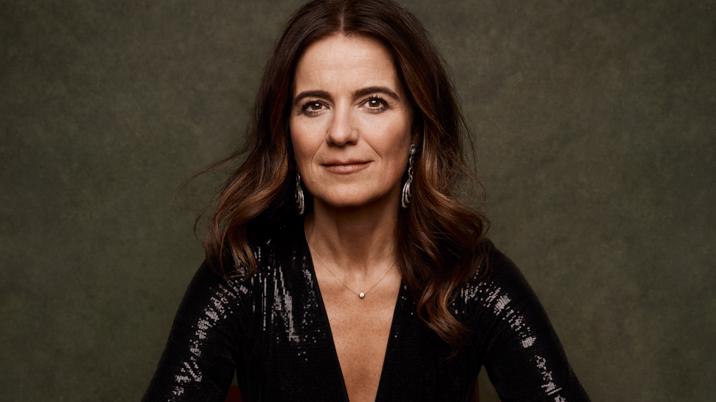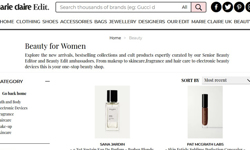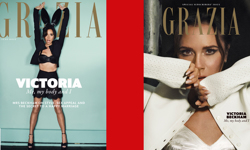
Luxury magazine brands’ resilience in the face of economic downturn has been widely documented and looks set to continue. Yet even Tatler – recently described by Vice as “the poshest magazine on earth” – can’t just simply rest on its gilded laurels. And following a restructuring of its commercial team, then the arrival of a new editor, changes resulting from both are now paying off. Digital revenue last year rose 25% on 2017 with half of the total from new business, and double-digit growth continuing into January and February 2019.
The Richard Effect
It is, says Publishing Director Kate Slesinger, ‘the Richard effect’ – a by-product of the arrival of editor Richard Dennen who achieved a 7% month-on-month circulation rise with the July 2018 edition: his first full issue. But you could just as easily put it down to a ‘Richard and Kate effect’ as some 90 brands – names such as Swarovski, Canada Goose, Vasdhi, Aquascutum, Celia Kritharioti and Ermanno Scervino – either went into Tatler in print or digital for the first time, or returned during 2018.

“Richard’s first job was to kick digital into shape, so digital and social content was upgraded and expanded to the point that across the Tatler brand, we now have a reach of 1.2m. And he has taken it in a direction Tatler had never dreamed of in terms of look – with art direction on digital now of the highest quality,” Slesinger explains.
This has made it easier for the commercial team to persuade advertisers digital is not a dumping ground for material that doesn’t make it into print. And it has enabled Tatler to start creating some highly successful branded content – a recent video featuring jewellery designer and socialite Sabine Getty for Chopard, for example, has been viewed over 30,000 times.
“It’s just something we’d not previously been able to do,” Slesinger continues. “Partly because the platform wasn’t able to host it, partly because the environment wasn’t there. But Richard has helped make digital (Tatler) more fitting for a host of new types of commercial activity.”
Dennen has made a number of other changes, too.
They are not people who spend even part of their time shopping in the high street.
Re-imagining the brand
He strengthened fashion coverage, and with it introduced a new emphasis on what Slesinger describes as “fashion that works hard”. He made the who’s-doing-what-where Bystander section more selective (to feature now, you’ve got to “rock a look”, not just be high born) then brought it to the front of the magazine.
He sloughed-off sections that felt outdated (such as the gadgets page). And he replaced a regular feature on people and their pets with carefully-selected pictures from the Tatler archives of people still pertinent today to underline the brand’s heritage and contemporary relevance.
The net effect has been that what ‘establishment’ means has been “re-imagined”, Slesinger concludes. And this is having a significant impact on perceptions of Tatler – especially among the luxury brands it courts.
To prove her point, she cites the front cover of Dennen’s first issue, which featured not a socialite but Nicole Kidman as its cover star. Then there was Tatler’s ‘Meet the New Debutantes’ feature in September, featuring young people with status thanks to the interest they generate because of what they do, rather than ‘just’ blood line.
“All those people in the (new debs) shoot undeniably have money, but they earned it in many cases rather than simply inherited it. And they spend that money in couture fashion – Bond Street, Beverley Hills. They are looking for very upscale fashion in luxury fashions houses and show rooms,” she notes.
“They are not people who spend even part of their time shopping in the high street.”
Tatler readers – the core of whom are women aged on average 45, 60% of whom live in London and the South East – spend £1.8bn a year on fashion; £1.3bn a year on watches and jewellery; and just under £1bn a year on beauty, according to PAMCo research.
When dealing with luxury brands you have to act as a luxury brand yourself.
New commercial opportunities
Now, having “taken a couple of seasons off from Tatler to recalibrate”, the fashion crowd – Italian fashion houses, especially – are recognising that. And this is providing Slesinger and her team with a host of fresh opportunities to exploit throughout 2019.
Supplements dedicated to special interests such as weddings, watches and jewellery, and cosmetic surgery are already lucrative and now growing commercially, with new additions to the portfolio being considered.
Video is another growth area, as is native and also events – which range from small exclusive launches, such as a Tatler dinner to launch Grace Hann’s new boutique, to Beauty Decoded Live, an evening to de-mystify cosmetic procedures in partnership with medical aesthetic treatments specialist Allergan.
Then there’s The Tatler Address Book – a digital listings resource for readers. Though it launched with health and beauty, additional topics will soon be added.
“It’s all about seizing the opportunities,” she continues. “We don’t have lots of cash to market our magazines, but we are working hard to be available in sufficient quantities at the right events and this year will up this further. Renewed confidence in a great product has made all the difference.”
Slesinger was appointed publisher of Tatler and Vanity Fair in May 2017 ahead of a re-structuring of both titles’ commercial teams into a single unit. Previously publishing director of House & Garden, she began her career at advertising agency JWT and her other publishing roles include associate publisher of Vogue and publisher of Condé Nast Traveller.
On the announcement of her new role, she talked of the opportunity to make life simpler for clients and ad agencies targeting affluent, influential consumers by delivering “a slick service responding to multiplatform as well as unilateral briefs, drawing on the wealth of talent and experience at our fingertips”.
The sweet spot will always be the creation of 360-degree platform partnerships.
Keeping it bespoke
But while a single, combined team makes it more streamlined dealing with agencies, when dealing with luxury brands you have to act as a luxury brand yourself - and that means adopting a style and approach that is tailored, she insists.
So, while Slesinger is responsible for both Tatler and Vanity Fair, which is driven from New York where its editorial team and US publisher are based, conversations with the luxury commercial partners that power each are tailored and concern one or other magazine brand at a time, not both.
The same applies to how Slesinger and her team work with central resources such as Condé Nast Commercial, which provides a full range of services for advertisers looking to run single campaigns across multiple Condé Nast platforms across multiple global markets.
While Tatler and Vanity Fair embrace opportunities to work on multi-platform projects, their joint commercial team’s own direct sell to clients will always be one-to-one and bespoke.
“The sweet spot will always be the creation of 360-degree platform partnerships. But as far as my team is concerned, each partnership is brand-specific. We don’t instigate anything here that runs jointly across Tatler and Vanity Fair to avoid any compromising situations or conflicts,” Slesinger confides.
“I’m blessed to have two brands, but they are almost self-selective. Our recent Grace Hann dinner could only have worked with Tatler. Conversely, we recently did a major event with Tiffany – The Bloomberg Vanity Fair Climate Exchange – that would never have worked with Tatler.”
Her point is: true luxury is personalised, not a cookie cutter mass produced item or service.
Every single non-display conversation with a client must be personal and tailored.
Platform agnostic
“In the 25 years I’ve worked in this building, the biggest change has been in the need for us to operate across a number of platforms fluently and really adapt something precisely to a client’s specific requirements,” she adds.
“Every single non-display conversation with a client must be personal and tailored – and that means not even cutting and pasting an email, because it’s best to have conversations one to one and face to face.
“On my team, everyone is a polymath or a polyglot, and they all speak digital, print and events. It’s a big change but a necessary one if your clients are to be nurtured and comforted towards trying new things. To perpetuate a relationship, it needs to be carefully fostered.”
Such an approach is what sets apart the true luxury expert from media brands now hungry to supplement declining mass-market ad spend with the luxury pound, Slesinger believes. Because if you optimise your commercial relationships – which she does in many ways, including regularly sharing her bulging contacts book with clients on anything from recruitment leads to holiday tips – there will be no gap into which your competition can slip.
Also important to retaining your luxury credentials is protecting the integrity of your luxury product, however. “I have to generate business, I have stiff targets,” she readily admits. “Who we want to work with is an on-going conversation. And marrying Richard’s and my ideas is a challenge in a world where there are ever more hands out for budgets.”
But, what marks Condé Nast out from its rivals is that it is “thoughtful”, she believes: “As a publishing director, you’ve got to engage the editor and have them trust you that the partners you are going to bring in are not going to undermine their product. That’s why you don’t automatically give out to the first person who offers to pay you £1m. The autonomy of the editor is really important.”
Important to retaining your luxury credentials is protecting the integrity of your luxury product.












